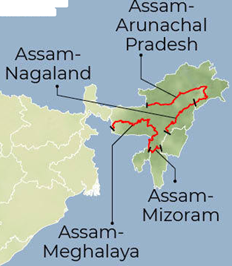Northeast India has been witnessing inter-state border disputes since the early 1960s when the process of reorganization of the state of Assam commenced. Border disputes of Northeast India mainly include inter-state conflict between Assam–Mizoram, Assam–Arunachal Pradesh, Assam–Nagaland and Assam–Meghalaya.

Disputes in North-East India
(i) Assam-Meghalaya dispute over 12 points including Langpih, Boko, etc. in Kamrup, Kamrup Metropolitan and Hailakandi districts. These disputes stemmed from ....